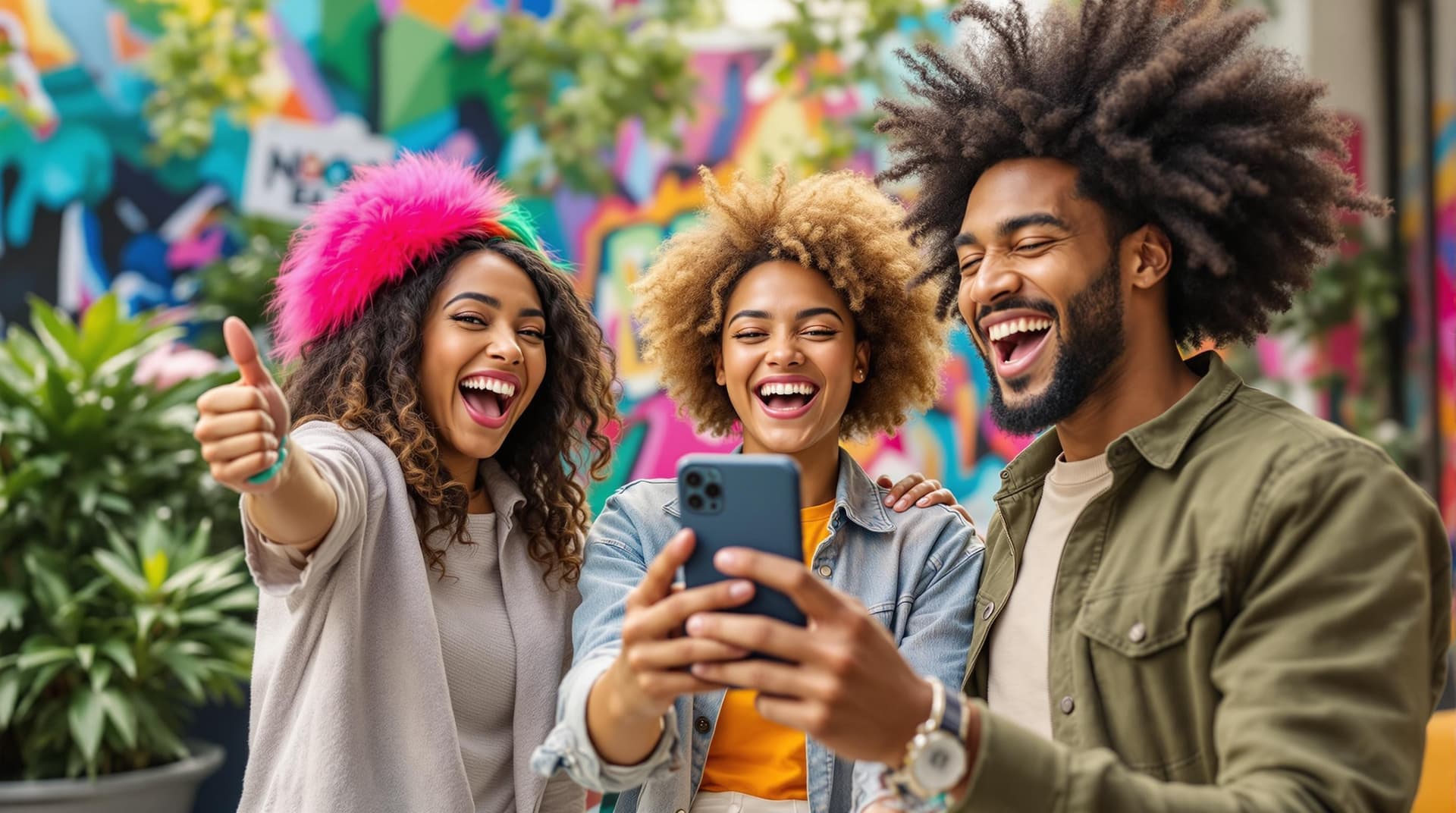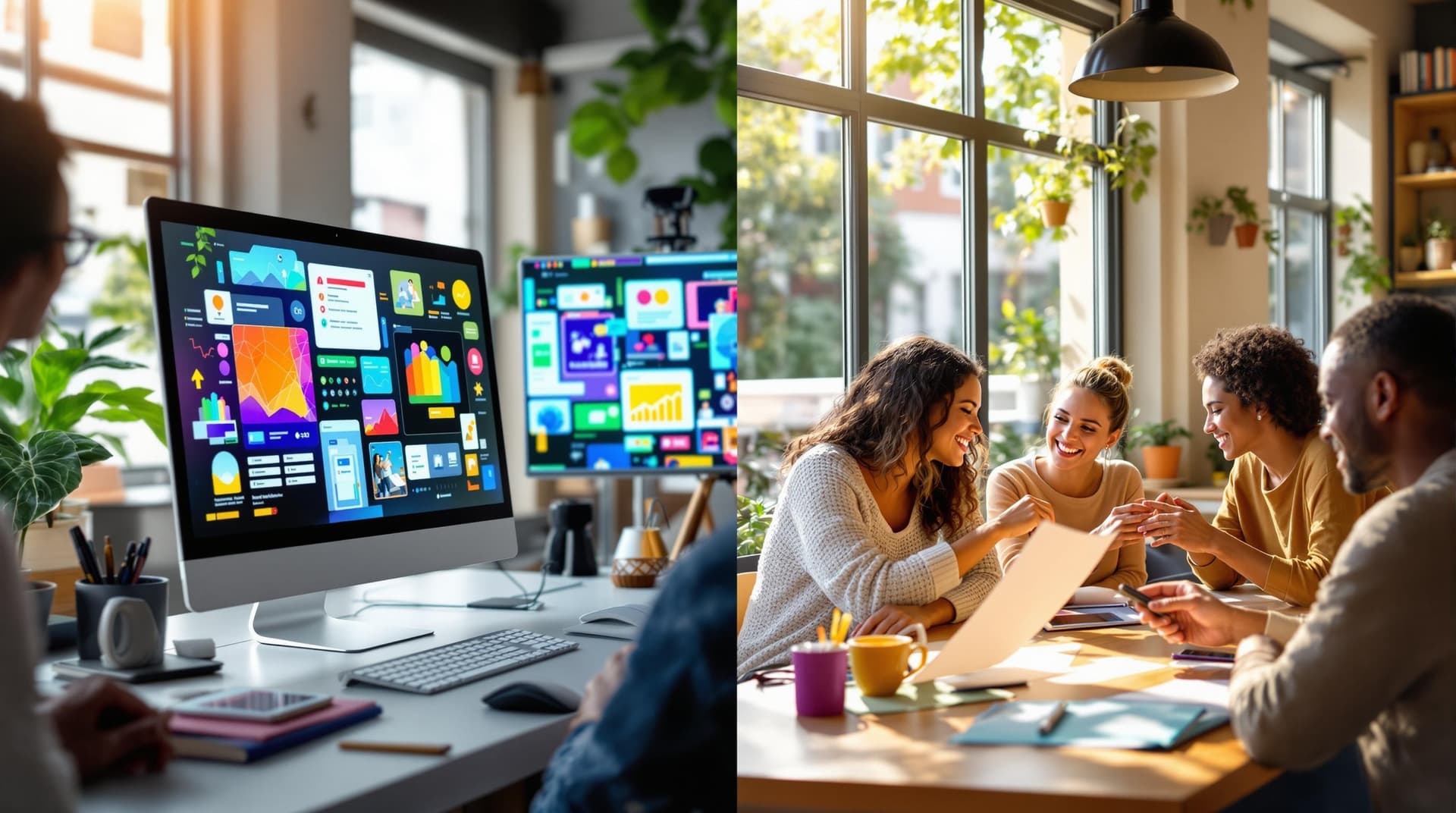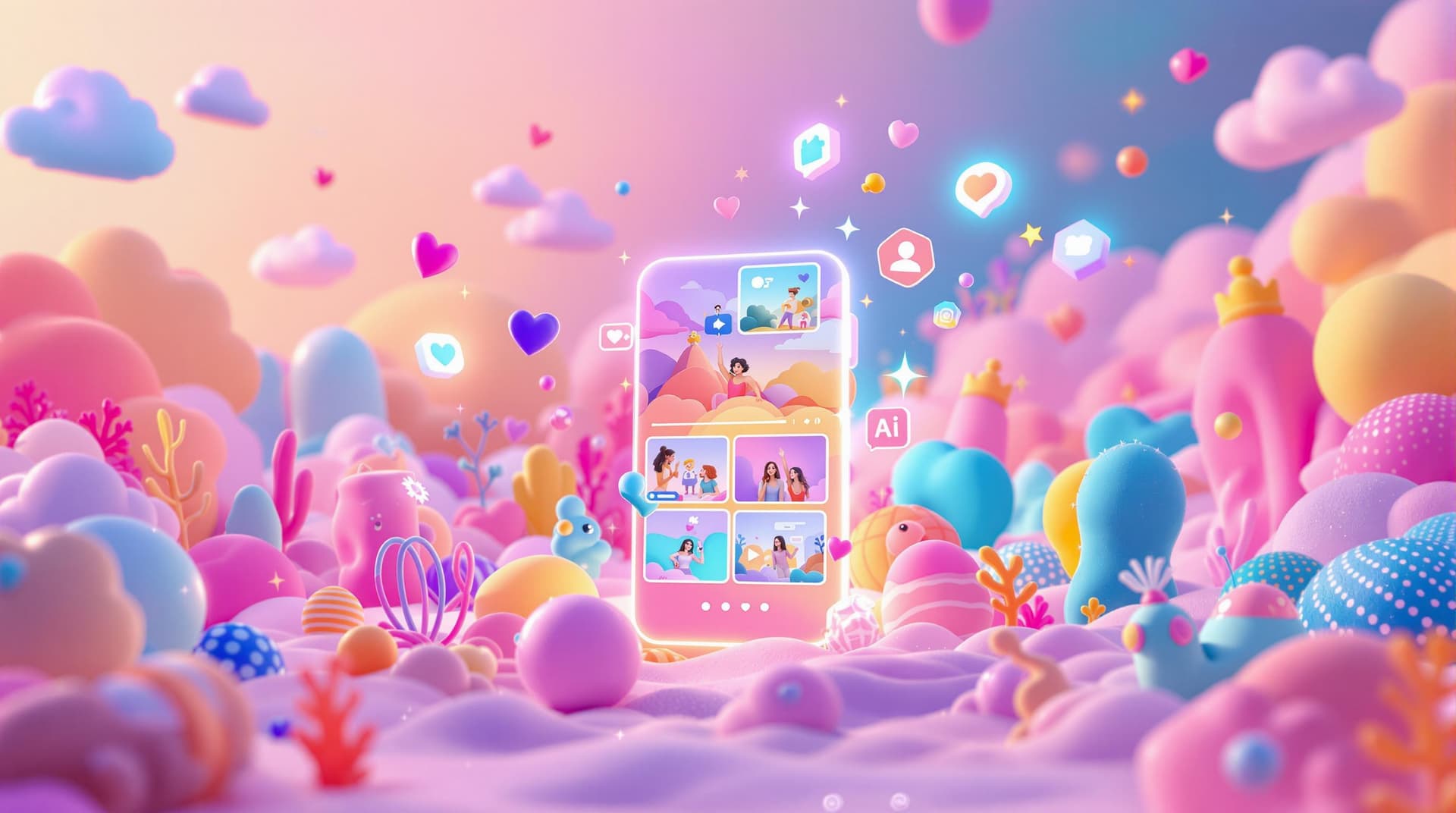Table of contents
- HOW TO INCREASE YOUR INSTAGRAM ENGAGEMENT IN 2025 | Tips, Tricks & Algorithm!
- Main Engagement Metrics That Algorithms Track
- Platform-Specific UGC Video Ranking Methods
- Research Findings on Engagement and UGC Performance
- Using AI Tools to Improve UGC Video Engagement
- Conclusion: Making UGC Videos Work with Algorithms
- FAQs

Social media algorithms prioritize user-generated content (UGC) videos based on engagement metrics like watch time, comments, shares, and saves. Platforms such as TikTok, Instagram, Facebook, and YouTube assess these interactions differently, tailoring their algorithms to user behaviors and content formats. Here's a quick breakdown:
- Engagement Metrics Matter Most: Likes, comments, shares, and saves all influence rankings, but meaningful interactions (e.g., comments and shares) carry more weight than passive actions like likes.
- Platform-Specific Priorities:
- TikTok: Focuses on watch time, rewatches, and shares, favoring content with trending sounds and viral potential.
- Instagram: Prioritizes searchable content and shares, with Reels being the top-performing format for reach.
- Facebook: Values overall interaction, including live engagement, and tracks audience retention.
- YouTube: Rewards videos that extend session duration, with recommendations driving 70% of views.
- AI's Role: Platforms use AI to refine algorithms, favoring genuine, relatable content over promotional material. AI tools also help creators optimize UGC for engagement and platform-specific standards.
- UGC Outperforms Branded Content: UGC videos generate higher trust, engagement, and conversions. For example, UGC on TikTok is 46x more effective than traditional ads.
For creators and brands, understanding these metrics and leveraging AI tools to produce engaging UGC can significantly improve visibility and ROI.
HOW TO INCREASE YOUR INSTAGRAM ENGAGEMENT IN 2025 | Tips, Tricks & Algorithm!
Main Engagement Metrics That Algorithms Track
Algorithms determine the visibility of UGC (user-generated content) videos by analyzing engagement signals. These signals help identify content that connects with viewers. For creators, understanding these metrics is key to increasing visibility and making a lasting impact.
Core Metrics: Watch Time, Comments, Shares, and Saves
Engagement metrics such as likes, comments, shares, and saves play a major role in how algorithms rank content. Each metric serves a distinct purpose:
- Likes show initial approval.
- Comments indicate deeper interaction.
- Shares expand the content's reach.
- Saves reflect long-term interest.
These interactions collectively boost visibility. However, not all engagement carries the same weight - some types of interactions matter more than others.
Quality vs. Quantity in Engagement Measurement
It’s not just about the numbers anymore. Algorithms now prioritize the quality of interactions over sheer volume. Posts that spark meaningful conversations or thoughtful responses rank higher than those that receive passive reactions. Timing also matters - a surge of activity shortly after posting can signal trending potential, while sustained engagement shows lasting relevance. Different platforms apply these principles in unique ways.
How Different Platforms Weight Metrics
Each platform has its own way of evaluating engagement, leading to varying strategies for creators:
- TikTok: With about 500 million posts analyzed daily, TikTok’s algorithm focuses on identifying highly engaging content. The platform boasts an engagement rate of 2.34%. Unlike other platforms, TikTok doesn’t heavily factor in follower count, making it a great option for new creators.
- Instagram: Instagram's algorithms prioritize reach over deep engagement. Each format - Feed, Stories, Explore, and Reels - has its own ranking criteria, requiring creators to adapt their approach for each.
- YouTube: YouTube takes a different approach by linking its short-form content (YouTube Shorts) to longer videos. The algorithm evaluates how well Shorts drive viewers toward more in-depth offerings.
Engagement rates also differ widely across platforms. TikTok boasts engagement rates ranging from 2.88% to 7.50%, depending on follower count, while Instagram’s rates fall between 1.77% and 3.65%. TikTok also generates three times more conversations compared to Instagram Reels, offering creators stronger opportunities for organic interaction. By understanding these platform-specific nuances, creators can fine-tune their strategies to achieve better results with algorithm-driven rankings.
Platform-Specific UGC Video Ranking Methods
Every major social media platform has its own way of ranking user-generated content (UGC) videos. These algorithms are tailored to match the platform's unique user behavior and content style. Knowing how each platform works can help creators fine-tune their strategies for better visibility.
TikTok: Prioritizing Engagement and Virality
TikTok's algorithm is all about relevance, not creator popularity. This means even new creators have a shot at going viral. The platform’s main goal? Maximize watch time by delivering the right content to the right audience at the perfect moment.
"At its core, the algorithm is built around one goal: maximize watch time and engagement by showing the right content to the right person at the right time."
Engagement signals like rewatches and shares carry more weight than likes or follows because they indicate deeper interest. Creators who produce high-quality content see significant results - 67% higher watch time per view, three times the number of views, and a 40× increase in followers. Plus, videos with background music get 98% more views.
TikTok creator Caroline Klidonas highlights the platform’s unpredictability:
"There's really no guarantee of what will work, so staying open and listening to your creative intuition is the key. If a video flops, but I had a good time making it, it's still a win."
To thrive on TikTok, creators should open with attention-grabbing hooks, use trending sounds to boost discoverability, and focus on engagement metrics like rewatches and shares. This emphasis on authentic interaction sets TikTok apart, but it also shares similarities with other platforms like Instagram and Facebook.
Instagram and Facebook: Engagement Metrics and Searchability
Instagram and Facebook focus on different engagement patterns, with Instagram leaning on searchable content and Facebook prioritizing overall interaction, including live engagement.
On Instagram, Reels generate more comments than other formats, while carousels lead in overall engagement rates (0.55%) compared to Reels (0.50%) and images (0.45%). The algorithm now favors searchable content, so using relevant keywords in captions and alt text is crucial. Social Media Manager Morgax Cox explains:
"Instagram's algorithm emphasizes searchable content, so optimizing posts with relevant keywords in captions and alt text is key for your content to be discovered."
For brands, Instagram Reels remain the top way to reach new audiences. Michelle King, CEO of Contelp, underscores this:
"In 2025, Instagram Reels remain the #1 way for brands to reach more people on Instagram. Short-form video content continues to perform best. With shares/views being the most critical metrics for the Instagram algorithm - creating short, shareable Reels that are funny, educational, inspirational, or emotional is the key to reaching a wider audience."
Facebook, on the other hand, evaluates engagement across all video types, from in-feed videos to Stories and Live content. A critical metric here is audience retention, which tracks when viewers start dropping off during playback.
Both platforms highlight the need for creators to adapt their strategies to match each algorithm’s priorities. Whether it’s optimizing for searchability on Instagram or engagement metrics on Facebook, aligning content with these goals is key.
YouTube: Long-Form Content and Viewer Sessions
YouTube’s ranking system focuses on extending overall session duration, making it distinct from platforms like TikTok and Instagram. Instead of prioritizing individual video completion, YouTube values videos that encourage viewers to stay on the platform longer.
Recommendations drive 70% of the content people watch on YouTube. Videos that are about eight to nine minutes long tend to perform better in search results, balancing viewer satisfaction and algorithm preferences.
The platform’s approach is more about the viewer than the video itself:
"YouTube optimizes search and discovery for videos that increase watch time on the site."
YouTube’s philosophy is clear:
"Our algorithm doesn't pay attention to videos; it pays attention to viewers. So, rather than trying to make videos that'll make an algorithm happy, focus on making videos that make your viewers happy."
Authentic engagement is rewarded, aligning with the broader trend across social media. YouTube favors videos that keep users watching, extend their time on the platform, and encourage them to view more ads. To succeed, creators should focus on content that hooks viewers, use playlists for seamless viewing, and add interactive features like annotations and end screens to maintain engagement throughout.
sbb-itb-d822133
Research Findings on Engagement and UGC Performance
Engagement metrics play a crucial role in the success of user-generated content (UGC) videos. Authentic content not only boosts reach and conversion rates but also significantly impacts campaign outcomes.
Case Studies of Engagement-Driven Success
Hurom partnered with inBeat Agency to shift from discount-based messaging to health-focused UGC. This strategy led to a 36% reduction in CPA and a 2.5× increase in ROAS.
NielsenIQ achieved a 75% drop in CPA and over 100,000 monthly app installs during the re-release of their Unroll.me app. By sourcing micro-influencers through inBeat Agency for TikTok ad content, they saw impressive results across major platforms.
The e-commerce industry has also seen strong results from UGC. For example, Dr. Dennis Gross integrated videos across 100+ website pages, including product carousels. Their shoppable videos alone generated over $50,000 in revenue, while video-engaged traffic led to 5,000+ orders worth over $1 million in 2023.
Similarly, True Classic reported a 13% conversion rate from viewers who interacted with shoppable videos in cart widgets in 2023. Busy Baby Mat saw an 11.49% average conversion rate from video-engaged visitors by placing UGC videos below the "add to cart" button, with peaks reaching 27%.
These examples illustrate how focusing on authentic engagement can drive measurable success.
How Real Content Drives Better Engagement
Authenticity is key to engagement, and algorithms reward it. Research shows that 68% of consumers trust UGC videos more than brand-produced content, and 79% are influenced by content from real people.
This trust translates into stronger algorithmic performance, with UGC videos achieving 55% more engagement than brand-created content. Younger audiences are particularly drawn to UGC, with 73% of Gen Z preferring it over traditional branded content.
Consumer behavior further underscores this trend. 82% of consumers have purchased or considered buying a product after seeing it featured by peers, and 40% say UGC is "extremely" or "very" important in their purchase decisions.
The Nielsen Consumer Trust Index reinforces these findings, showing that 92% of people trust recommendations from friends and family, compared to just 33% who trust television ads. This explains why platforms prioritize UGC - it keeps users engaged and active for longer periods.
UGC vs Branded Content Performance Data
The performance gap between UGC and branded content is clear across various metrics. Here's how they compare:
| Metric | UGC Performance | Branded Content | Advantage |
|---|---|---|---|
| Consumer Trust | 68% | 32% | +36% |
| Gen Z Preference | 73% | 27% | +46% |
| Purchase Influence | 79% | 21% | +58% |
| Purchase Consideration | 82% | 18% | +64% |
Platform-specific data highlights even stronger results. On TikTok, UGC is 22% more effective than branded content and outperforms Facebook ads by 32%. In fact, UGC on TikTok is 46 times more effective than regular ads. On YouTube, UGC videos and shorts attract nearly 10 times more views than branded content.
UGC also drives higher engagement. Social campaigns with UGC see a 50% boost in engagement, and combining UGC with brand content raises engagement by 28%.
When it comes to cost efficiency, UGC delivers even more value. Ads featuring UGC achieve 4x higher click-through rates and cut cost-per-click by 50%. Brands using UGC in social media ads reduce costs by half while maintaining strong performance.
In terms of conversions, UGC has a significant impact. Campaigns featuring UGC lead to 29% higher web conversions, and e-commerce product pages see a 161% increase in conversions when UGC is included. Consumers also find UGC nearly 10 times more influential than influencer content when making purchase decisions.
These metrics show why platforms favor UGC - it drives engagement, keeps users active, and delivers results that outperform traditional branded content.
Using AI Tools to Improve UGC Video Engagement
AI tools are changing how user-generated content (UGC) videos are created, making it easier for brands to craft content that aligns with social media algorithms. By analyzing data from millions of successful videos, these platforms help brands expand their reach and improve conversion rates - all while cutting down on traditional production costs.
AI Content Creation for Better Engagement
AI platforms are designed to create UGC videos that align with the preferences of social media algorithms. Take MagicUGC, for example. Their AI models are trained on over 1 million high-performing TikTok and Instagram videos to pinpoint the patterns that drive engagement.
One standout feature of MagicUGC is AI Script Optimization. This tool examines the structure of successful content and generates scripts tailored to a brand's voice and specific campaign objectives. The result? Content that keeps viewers hooked from beginning to end - a critical factor that algorithms reward. Additionally, AI can customize UGC videos for specific audiences, ensuring relevance and boosting distribution.
"AI doesn't just make better UGC, it also helps get marketing teams UGC in front of more eyes quicker." – Joe Tobin, Head of Content, Billo
Another key capability is localization. AI tools can adapt content to resonate with audiences in different markets, ensuring strong engagement across various demographics. This localization has allowed international brands to achieve a 60% faster campaign turnaround.
AI platforms also refine videos to meet the unique standards of each platform, whether it’s TikTok’s short clips or YouTube’s longer formats. Paired with real-time analytics, these tools help brands continuously improve their content strategies for maximum engagement.
Analytics Tools for Algorithm Adaptation
Once content is created, analytics tools step in to help brands adapt to shifting algorithm trends. AI platforms provide real-time insights into metrics like engagement, conversion rates, and ROI, enabling brands to tweak their strategies as needed.
These tools monitor multiple engagement signals - such as watch time, shares, comments, and click-through rates - all at once. From this data, AI can suggest the best times and platforms for posting UGC, ensuring maximum reach and interaction. By identifying performance trends, the system also recommends content adjustments to align with current algorithm preferences.
This data-driven approach doesn’t just improve engagement; it also cuts down on wasted spending. Brands using AI analytics have reported a 30% boost in ROI. Additionally, AI-driven feedback loops refine content over time, helping brands fine-tune elements like tone, themes, and editing styles based on what works best.
Improving ROI with Custom UGC Solutions
AI platforms are proving to be a game-changer for ROI. By reducing production costs and driving higher engagement, these tools are reshaping how brands approach marketing. Companies using AI for content creation have saved up to 30% on production costs. UGC-based ads, in particular, deliver 4x higher click-through rates and cut cost-per-click by 50% compared to traditional ads.
For example, MagicUGC offers flexible plans to suit different business needs. Their Basic Plan, priced at $149/month, includes up to 20 AI-generated UGC videos with 2 AI avatars. The Pro Plan, at $179/month, provides 50 videos and advanced analytics, while the Turbo Plan, priced at $249/month, offers unlimited videos, 10 avatars, and a dedicated success manager.
Consistent posting is another area where AI shines. 24/7 content generation ensures brands maintain a steady flow of posts, a key factor in staying on the radar of social media algorithms. Tools also ensure that all content aligns with a brand’s identity and incorporates emotional elements to connect with audiences - factors that are crucial for driving engagement.
AI’s scalability is particularly beneficial for growing brands. Instead of juggling freelancers or managing complex productions, businesses can instantly generate multiple video variations, test them, and scale the ones that perform well. This efficiency has allowed many brands to cut costs while seeing measurable improvements in their campaigns.
"AI's greatest strength is automating tasks." – Joe Tobin, Head of Content, Billo
With 54% of marketers already using AI for video editing and creation and 80% relying on AI for marketing content, it’s clear that AI has become a must-have for brands looking to stay competitive in the UGC space.
Conclusion: Making UGC Videos Work with Algorithms
User-generated content (UGC) has a knack for catching the attention of algorithms, often driving results like 10x more YouTube views compared to branded content. This highlights the power of actionable strategies that align with key engagement metrics.
Key Engagement Metrics and Algorithm Insights
The success of UGC videos largely depends on factors like watch time, comments, shares, and saves - all of which contribute to greater visibility. While platforms may prioritize these metrics differently, the core idea remains the same: content that sparks engagement gets rewarded with increased reach.
Brands leveraging engagement-focused strategies not only achieve better visibility but also see improvements in performance metrics like lower CPAs and higher conversion rates. Authenticity plays a big role here. As Irinna Stefanidou from United Nude puts it:
"In general, people from the new generation trust people more than they trust brands and they are tired of only seeing perfect pictures of models. As a brand we need to listen to this and learn more about the people that are actually buying our products."
The numbers back this up: 75% of brand-related content in strong online communities is user-generated, and brands incorporating UGC experience 29% higher web conversions compared to those sticking to traditional ads. To keep up, many brands are turning to AI tools to streamline and scale their UGC efforts.
AI's Role in Simplifying UGC Video Creation
AI tools are changing the game by addressing some of the biggest challenges in UGC production. These platforms can cut production time by over 30% and reduce costs by about 25%.
Take MagicUGC, for example. This platform uses AI trained on more than 1 million top-performing TikTok and Instagram videos to create engaging UGC without the need for filming or manual editing. Their pricing starts at $149 per month for the Basic Plan, which includes 20 AI-generated videos and 2 AI avatars, and goes up to the Turbo Plan at $249 per month, offering unlimited videos and 10 avatars. This flexibility caters to different content needs, whether you're a small business or a larger brand.
The market is also embracing this shift. The global AI video generator market is expected to grow from $5.39 billion in 2025 to $62.89 billion by 2034, with an annual growth rate of over 20%. This surge reflects the practical advantages AI offers, such as 24/7 content generation, multilingual capabilities, and the ability to produce multiple variations for testing.
FAQs
How do social media algorithms decide which UGC videos to rank higher based on engagement?
Social media platforms use algorithms to rank user-generated content (UGC) videos, prioritizing engagement quality. This means they pay closer attention to interactions like comments, shares, and longer watch durations - signals that show genuine interest and connection with the content.
On the other hand, passive metrics like likes or basic views carry less weight, as they don't necessarily reflect meaningful engagement. By emphasizing active participation, these algorithms aim to highlight content that truly connects with and resonates with users.
How can creators tailor their videos to perform well on platforms like TikTok and YouTube?
To make your videos shine on TikTok, focus on a few key strategies. Use trending hashtags and popular audio tracks to boost discoverability. Pair this with engaging captions that include relevant keywords to draw attention. Consistency is also crucial - posting regularly helps you stay visible. Since TikTok's algorithm favors content that keeps viewers hooked, aim for short, captivating videos that inspire likes, comments, and shares.
For YouTube, optimizing your video titles, descriptions, and tags with relevant keywords is essential for better search rankings. Don’t underestimate the power of a striking thumbnail - it can make or break a click. Encourage your audience to like, comment, and subscribe, and stick to a consistent posting schedule. Both platforms reward videos that excel in watch time, engagement, and relevance, so always prioritize creating high-quality, valuable content that resonates with your audience.
How do AI tools improve UGC videos to perform better with social media algorithms?
AI tools are changing how UGC videos are made and fine-tuned for social media. Using advanced algorithms, they automate video creation, cutting down on time and effort while still delivering top-notch results. These tools also track engagement metrics and trends, helping creators craft videos that connect with their audience.
On top of that, AI can produce customized, attention-grabbing content designed to work seamlessly with platform-specific algorithms. With capabilities like automatic script writing, support for multiple languages, and easy video adjustments, these tools make it easier to create videos that stand out and drive interaction.



